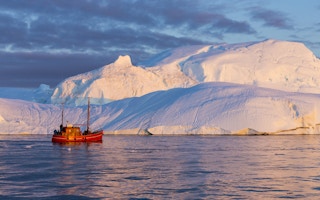Scientists have established at least one factor in the record melting of northern Greenland in 2015. The Arctic itself played a hand in what happened.
In a process that engineers call positive feedback, high atmospheric pressure and clear skies over the Arctic region practically committed the northwest of Greenland to an episode of melting at record rates.
And because the Arctic is the fastest-warming region on Earth, and because atmosphere and ocean influence each other, the steady loss of sea ice each year has forced a change in wind patterns. This in turn has played back into the climatic machinery, according to a new study in Nature Communications.
“How much and where Greenland melts can change depending on how things change elsewhere on Earth,” said Marco Tedesco, of Columbia University’s Lamont-Doherty Earth Observatory, who led the research.
“If loss of sea ice is driving changes in the jet stream, the jet stream is changing Greenland, and this, in turn, has an impact on the Arctic system as well as the climate. It’s a system, it is strongly interconnected, and we have to approach it as such.”
Worldwide impact
Greenland’s burden of ice is the greatest in the northern hemisphere, and second only to Antarctica’s. If Greenland’s ice all melted, sea levels would rise worldwide by seven metres.
So what scientists call “Arctic amplification” isn’t just a bit of climate science jargon, it is also a phenomenon that matters immensely to humans everywhere.
The process works like this. The Arctic is warming faster as the sea ice disappears. This is because solar radiation which would have been reflected by a sheet of ice is being absorbed by blue water, which speeds up the warming further.
And since the temperature difference between the Arctic and the tropics is narrowing, and since it’s the temperature difference that drives wind and ocean currents, then the jet stream that normally whizzes around the Arctic circle – thus keeping frozen air in one place and separating it from the warm breezes of the south – is, the theory goes, slowing, thus allowing warm moist air to penetrate into the north. And, it seems, to melt even more of Greenland.
Professor Tedesco has been observing the intricate interplay of snow, ice, wind and sunlight in Greenland for years. Last year he and others examined the record melt of 2012 to piece together the rate of flow of water to the seas.
“
The conditions we saw in the past aren’t necessarily the conditions of the future. If humans change the forcing, we are going into uncharted territory.
Marco Tedesco, researcher, Columbia University’s Lamont-Doherty Earth Observatory
Earlier this year he and others pinpointed a change in albedo – a measure of the reflectivity of snow on the island – that suggested that melting might accelerate.
The latest study doesn’t declare the process of Arctic amplification guilty as charged: science proceeds cautiously and the researchers say only that the melting process observed in 2015 is “consistent” with the hypothesis of Arctic amplification.
In fact, the jet stream swung north to latitudes never before observed at that time of year; the winds during July reversed their normal pattern, and southern Greenland – where melting has been at record levels for most of the decade – actually saw more snowfall and lower melting in 2015.
Climate change is happening, being driven by the human combustion of fossil fuels at unprecedented rates for more than a century. But how the climate will change is harder to guess. The suspicion is that – if the Arctic amplification process works in the way that scientists think it must do – then climate change in the Arctic can only accelerate. But right now, all researchers can do is watch, record and measure.
“The conditions we saw in the past aren’t necessarily the conditions of the future,” Professor Tedesco said. “If humans change the forcing, we are going into uncharted territory.”








